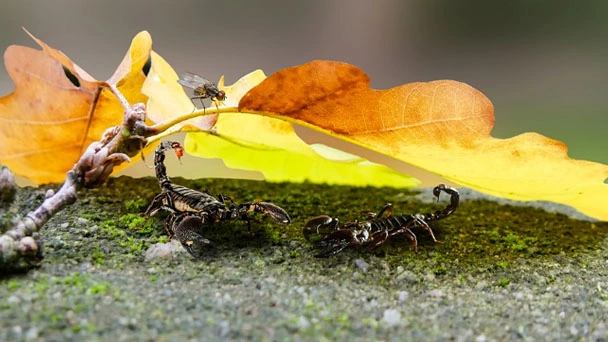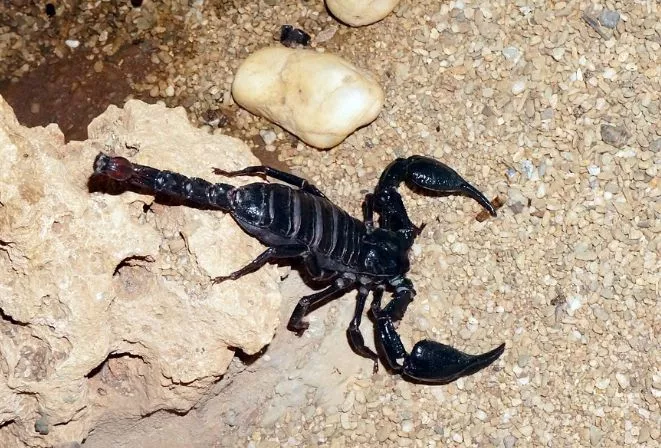How to Get Rid of Scorpions from Your Garden Safely
Written by Ivy
Jan 06 2023

Except for Antarctica, every continent is home to the venomous, predatory pest known as the scorpion. Though it may hurt, being stung by one usually won't result in your death. But you still want to get rid of scorpions that show up in your house or garden.
The Nonlethal Method: Capture and Release
An inside scorpion can be safely escorted outside:
- Cover it: The scorpion should be covered with a quart-sized glass jar.
- Trap it: Slide a thick piece of construction paper underneath.
- Flip it: Flip the paper upside-down while holding it securely in place. The scorpion is going to hit the ground first.
- Remove it: Place the jar outside after tightening the lid. Far outside.
A homeowner's tip: You can pick up the scorpion and put it in the screw-top jar using forceps that are at least 10 inches long. If you can resist closing them the final half-inch, hedge shears or a branch clipper can also work. The pruning shears are too short to be useful; resist the urge to use them.
Lethal Methods: Squash Or Spray
How to kill a scorpion:
- Squash it with a shoe or another object. The best way to prevent getting stung is to not be wearing the shoe at the time.
- Spray it. Use a pesticide if you have one on hand, but keep in mind that it's toxic, making it a concern if you have small children or pets. If you do use a pesticide, open windows right away and remove any pesticide stains.
- Stick it. Lay out a glue board. Remember that other animals (such as insects, crickets, and mice, for example) will be stuck to the sticky trap, and take care to keep children and pets out of it.
- Tape it. Pick it up with duct tape, fold the tape over it, and throw it away.
- Roll it. Squash and remove it with a long-handled lint brush, then throw away the roller.
How to Get Rid of a Scorpion
Be careful using any of the following do-it-yourself methods:
Spider Spray
Given that they belong to the same class of arthropods as spiders, arachnids, which include scorpions, many of which are poisonous, can also be used to kill them. A single scorpion can be killed using any of the spider sprays sold at the supermarket. Spider repellents should only be used sparingly because they could harm your pets.
Shoes & Knives
Despite their power, you can stomp on scorpions to squash them or use a knife to cut through their skin. But keep in mind that you need to be very close to a scorpion to kill it using one of these techniques, so it might be best to keep a brick or sledgehammer close by.
Boric Acid/Borax
Natural substances that can be sprayed or applied to scorpions to eventually kill them include boric acid and, to a lesser extent, borax. As the chemical dehydrates the scorpions, the process is relatively slow. The scorpion will still have time to sting because it will take some time. Boric acid should not be given to pets as it can be harmful if inhaled or consumed by them.
Rodent Traps
Setting up rat and mouse traps in your home might work out okay.
Diatomaceous Earth (DE)
Diatomaceous earth, a powder made from fossilized diatoms that is safe for both people and animals, is another substance that has the same dehydrating effect. The scorpion's exoskeleton is cut by its jagged edges. DE can be sprinkled both inside and outside, across door thresholds, and in crevices and cracks where scorpions are likely to come into contact with it. DE also aids in controlling other kinds of insects, which is an added bonus.
Cats
Cats are skilled at catching and killing scorpions, but you still need to be cautious because they could get stung or hurt. In the event that you raise chickens, they can also aid in population control.
Sticky Traps
Small rodent traps can also be used to catch scorpions. Place them close to water sources, in dark places where scorpions like to hide, like closets, near entryways, in garages, and anywhere else you have seen scorpions. Try to find non-toxic types of traps if you have pets or kids. You can keep an eye on the scorpion population inside your home by setting glue traps.
At night, when scorpions are most active, is the best time to go scorpion hunting. They glow in the ultraviolet, so you can find them by using a black light bulb in a flashlight. Wearing long sleeves, gloves, closed-toe shoes, and long pants will help you search safely. When handling scorpions, long tweezers can help you maintain your distance.

Best Pesticides for Scorpion Control
A. Using Residual Insecticides
Use residual insecticides both in liquid and dust form during the spring and summer. Either an encapsulated insecticide like Avesta CS or a wettable powder formulation like Demon WP that mixes with water like are recommended.
Apply insecticide dust to vacant spaces. Our suggestion is D-Fense Dust. Additionally useful are DIY pest control trapper insect traps placed inside along baseboards.
The perimeter of the building, harborage areas, and potential entry points, such as those around all windows and doors, along baseboards, plumbing, inside closets, and in the basement and garage, should all be treated with insecticides in a 3 to 10-foot band.
When applied to dark surfaces, Both Demon WP's wettable powders may leave a trace of their presence. Avesta CS has a lengthy residue and a broad label (it kills numerous insects). It is odorless, odorless when dry, and can be used indoors or outdoors. Due to its encapsulated technology, Avesta CS will last longer outside and stick to the surface better. Avesta CS 8 oz; 16 gallons produced.
These odorless insecticides can be used both indoors and outdoors, and they have no unpleasant smell.
B. Using Insecticide Dusts
If the attic is a point of entry, insecticide dust should be used there. Using a duster, you can apply insecticide dust such as D-Fense Dust or Drione Dust. This dust would be helpful in cracks and crevices, wall voids, electrical fittings, around door and window frames, etc.
A garden duster like the Dustin Mizer is practical for dusting the attic area. You can easily and quickly crank out one pound of dust from it.
C. Using Glue Boards
Placing insect glue boards along the edges of walls and under furniture is an additional control measure and a non-toxic method of controlling scorpions.
Also Read How to Get Rid of the Following Species:
Animals:
- Ant
- Brown Recluse Spiders
- Hornets
- Palmetto Bugs
- Spider Mites
- Water Bugs
- Black Caterpillars
- Grass Flies
- Carpenter Bees
- Beetles
Common Types of Scorpions in America
Bark Scorpion (Centruroides Exilicauda)
Venom: Dangerous to people
Range: Arizona, in Southeastern California, Nevada, and New Mexico
Size: 3 inches long
Tail: Very thin, only 1/16 inch wide
Body: Yellow without stripes or patterns
Habitat: the only scorpion that climbs that is common. lives in rocky cliff crevices and under tree bark.
Around a home: It frequently enters homes because it can climb and requires a narrow opening of just 1/16 inch.
Giant Hairy Scorpion (Hadrurus Arizonensis)
Venom: Not considered potent
Range: Arizona and Southern California's deserts.
Size: 5 to 7 inches long
Tail: Its Latin name is "thick-tailed from Arizona."
Body: yellow with top-to-bottom dark stripes. Its name is derived from the body's protruding hairs, which sense vibrations.
Habitat: A burrower, but discovered on the ground beneath rocks, logs, and other objects.
Around a home: a night feeder drawn to irrigated land and bodies of water (pools). looking for water by breaking into houses.
Stripedtail Scorpion (Vaejovis Spinigerus)
Venom: Not considered dangerous
Range: Throughout the U.S.
Size: 2 1/2 inches long
Tail: Thicker than its other limbs, long
Body: Top-striped pale yellow color.
Habitat: In sandy soil, a burrower was discovered. crevices under rocks and logs are dug out.
Around a home: under typical items like shoes and sleeping bags. In search of food (crickets, small insects), will enter the house.
FAQs
What Kills Scorpions Naturally
It is possible to kill scorpions by spraying or applying borax, which is a natural substance.
Will Bleach Kill Scorpions
When scorpions are present and untamed, you may use bleach. Spray it where they typically hide, in my opinion. Bleach can be applied directly to scorpions in an emergency. It will kill them instantly.
Will Vinegar Kill Scorpions
For one thing, most people don't realize vinegaroons are very efficient predators of scorpions and many pesky insects and much cheaper than an exterminator.
Does Hairspray Kill Scorpions
There are numerous items around the house that can be used to get rid of creepy crawlies for those who can't find bug spray or get to the phone quickly enough to call pest control. Here are a few tips that work: On scorpions and cockroaches, use hairspray.
How to Humanely Kill a Scorpion
Despite their strength, you can stomp on scorpions to squish them or use a knife to pierce their outer shell. However, keep in mind that you need to be very close to a scorpion in order to kill it using one of these techniques, so it might be smarter to keep a brick or sledgehammer close by.
Latest Updated
- Benefits of Bugleweed - 7 Science-backed Health Benefits
- Bugleweed Dangers & Side Effects - Is It Poisonous?
- How to Plant Evergreen Trees - What You Should Know
- When to Plant Evergreens - Grow Guide for Evergreen Trees
- 12 Wonderful Evergreen Shrubs for Your Garden
- 12 Popular Evergreen Plants with Pictures for Beginners
- When And How To Prune A Lilac Bush Like a Pro
- How to Grow & Care for Lilac Vine (Hardenbergia Violacea)
- Japanese Lilac Tree (Syringa Reticulata) Care & Propagation Guide
- Shumard Oak Pros and Cons - What to Know
Popular Articles
- Winter maintenance of Antirrhinum Majus
- How to Grow Terminalia Mantaly Tree
- How to Grow and Care for Crossostephium Chinense
- How to grow Antirrhinum Majus in spring
- Peristeria Elata (Dove Orchid) Profile: Info & Care Guide
- Underwatered Snake Plant (Sansevieria Trifasciata) - Signs And How To Fix
- How to Care for Brazilian Jasmine Plant (Mandevilla Sanderi)
- How to Grow & Care for Graptopetalum Purple Delight in Summer
- Rosa Chinensis (China Rose): Plant Growing & Care Tips
- How to Care for Baby Sun Rose (Aptenia Cordifolia)